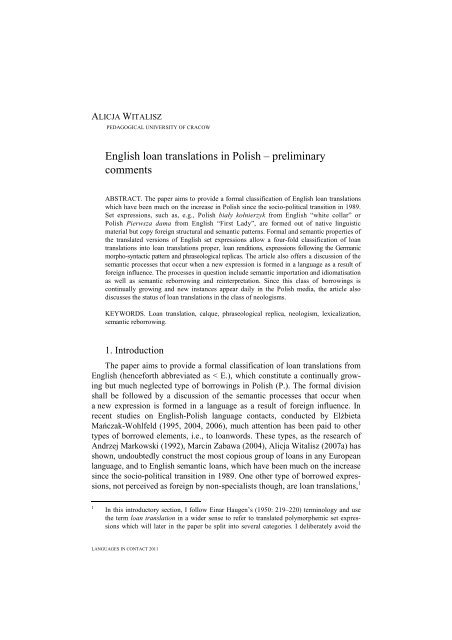s - Wyższa SzkoÅa Filologiczna we WrocÅawiu
s - Wyższa SzkoÅa Filologiczna we WrocÅawiu
s - Wyższa SzkoÅa Filologiczna we WrocÅawiu
You also want an ePaper? Increase the reach of your titles
YUMPU automatically turns print PDFs into web optimized ePapers that Google loves.
ALICJA WITALISZ<br />
PEDAGOGICAL UNIVERSITY OF CRACOW<br />
English loan translations in Polish – preliminary<br />
comments<br />
ABSTRACT. The paper aims to provide a formal classification of English loan translations<br />
which have been much on the increase in Polish since the socio-political transition in 1989.<br />
Set expressions, such as, e.g., Polish biały kołnierzyk from English “white collar” or<br />
Polish Pierwsza dama from English “First Lady”, are formed out of native linguistic<br />
material but copy foreign structural and semantic patterns. Formal and semantic properties of<br />
the translated versions of English set expressions allow a four-fold classification of loan<br />
translations into loan translations proper, loan renditions, expressions following the Germanic<br />
morpho-syntactic pattern and phraseological replicas. The article also offers a discussion of the<br />
semantic processes that occur when a new expression is formed in a language as a result of<br />
foreign influence. The processes in question include semantic importation and idiomatisation<br />
as <strong>we</strong>ll as semantic reborrowing and reinterpretation. Since this class of borrowings is<br />
continually growing and new instances appear daily in the Polish media, the article also<br />
discusses the status of loan translations in the class of neologisms.<br />
KEYWORDS. Loan translation, calque, phraseological replica, neologism, lexicalization,<br />
semantic reborrowing.<br />
1. Introduction<br />
The paper aims to provide a formal classification of loan translations from<br />
English (henceforth abbreviated as < E.), which constitute a continually growing<br />
but much neglected type of borrowings in Polish (P.). The formal division<br />
shall be follo<strong>we</strong>d by a discussion of the semantic processes that occur when<br />
a new expression is formed in a language as a result of foreign influence. In<br />
recent studies on English-Polish language contacts, conducted by Elżbieta<br />
Mańczak-Wohlfeld (1995, 2004, 2006), much attention has been paid to other<br />
types of borro<strong>we</strong>d elements, i.e., to loanwords. These types, as the research of<br />
Andrzej Markowski (1992), Marcin Zabawa (2004), Alicja Witalisz (2007a) has<br />
shown, undoubtedly construct the most copious group of loans in any European<br />
language, and to English semantic loans, which have been much on the increase<br />
since the socio-political transition in 1989. One other type of borro<strong>we</strong>d expressions,<br />
not perceived as foreign by non-specialists though, are loan translations, 1<br />
1<br />
In this introductory section, I follow Einar Haugen’s (1950: 219–220) terminology and use<br />
the term loan translation in a wider sense to refer to translated polymorphemic set expressions<br />
which will later in the paper be split into several categories. I deliberately avoid the<br />
LANGUAGES IN CONTACT 2011
















